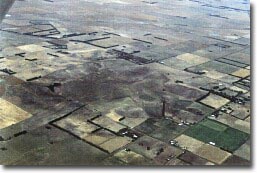Mount Shadwell
|
This information has been obtained from the report: Eruption Points of the Newer Volcanic Province of Victoria by Neville Rosengren. This report was published in 1994 and was prepared for the National Trust of Australia (Victoria) and the Geological Society of Australia (Victorian Division). The review of eruption points was based on an earlier unpublished manuscript Catalogue of the post-Miocene volcanoes of Victoria compiled by O P Singleton and E B Joyce (Geology Department, University of Melbourne 1970). |
| Location: | 38 03 30S 142 49 00E (external link); 7421-1-4 (Mortlake) 587863. 2 km N of Mortlake. Mortlake-Ararat Road, Mortlake. |  Mt Shadwell. |
Land Tenure/Use: | Private land. Grazing, bare. Large operating quarry at base on eastern flank, smaller pit on north, two smaller pits on south. | |
Type 5: | Multiple scoria eruption points with craters. | |
Mount Shadwell is the highest of a group of scoria cones overlying a small accumulation of tuff and surrounded by lava flows. There is no distinct enclosed crater as the scoria mounds overlap, creating several shallow crater-like depressions. The arrangement of scoria mounds suggests an original crater with a high southern rim opening towards the north-west but largely covered by later eruptions. The scoria is both red and black, coarse and contains numerous basalt blocks and bombs. Mount Shadwell is a noted source of olivine and augite ultramafic xenoliths, as well as clinopryoxene and orthoclase megacrysts contained in basalts and scoria. The host rock is basanite which is the most common lava of the explosive centres. | ||
292 m; 135 m. | ||
Regional: | This is a good example of a multiple eruption volcano with scoria mounds filling the craters. It illustrates a gradually declining phase of fire fountaining, rather than an abrupt ending of activity. | |
References: | Ollier, C.D. & Joyce, E.B. 1964. Volcanic physiography of the Western Plains of Victoria. Proceedings of the Royal Society of Victoria 77, pp 357-376. Irving, A.J. 1974. Megacrysts from the Newer Basalts and other basaltic rocks of south-eastern Australia. Geological Society of America Bulletin 85, pp. 1503-1514. | |

Mt Shadwell.


